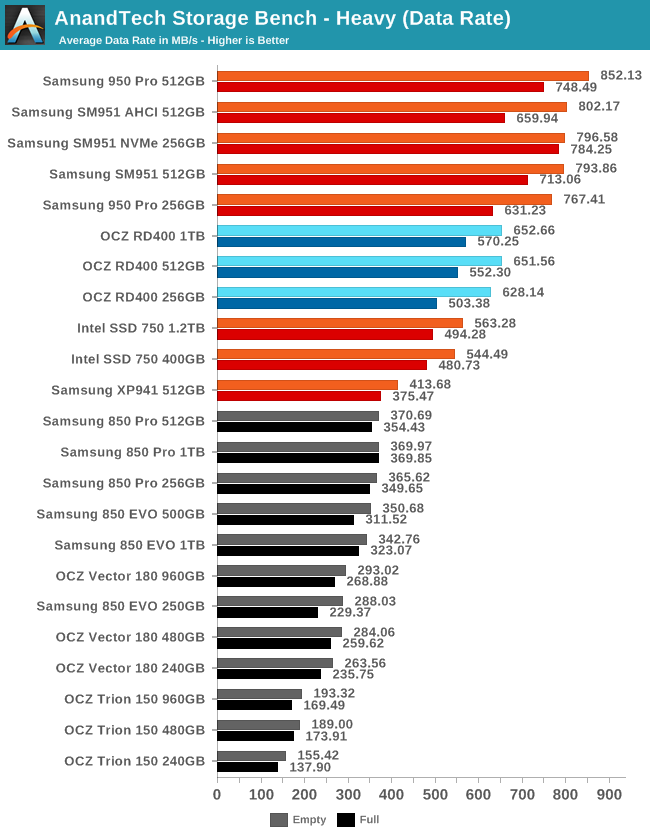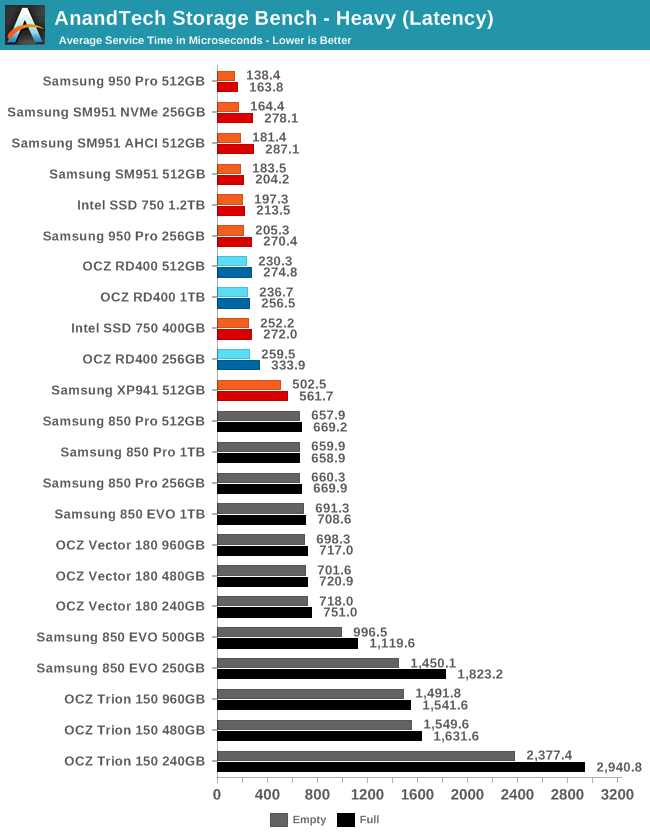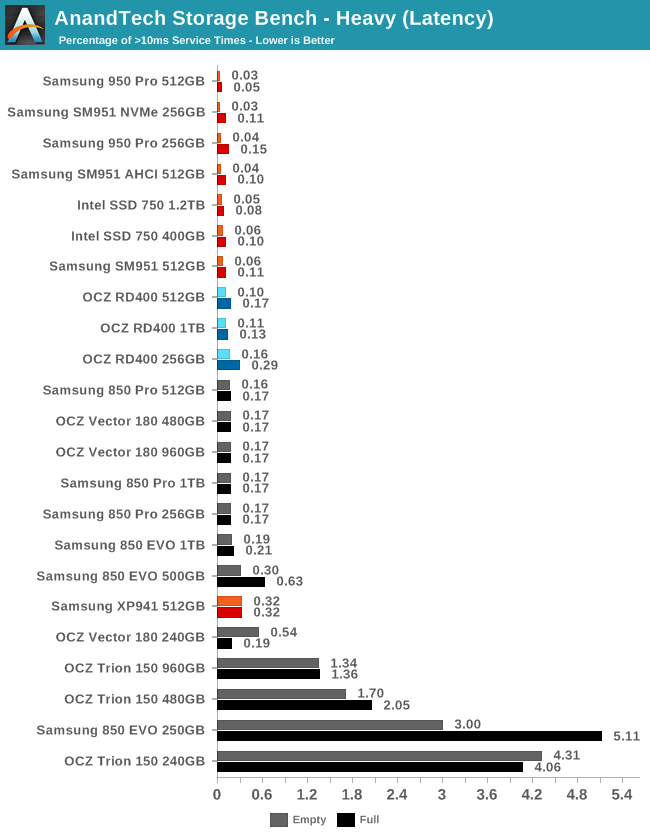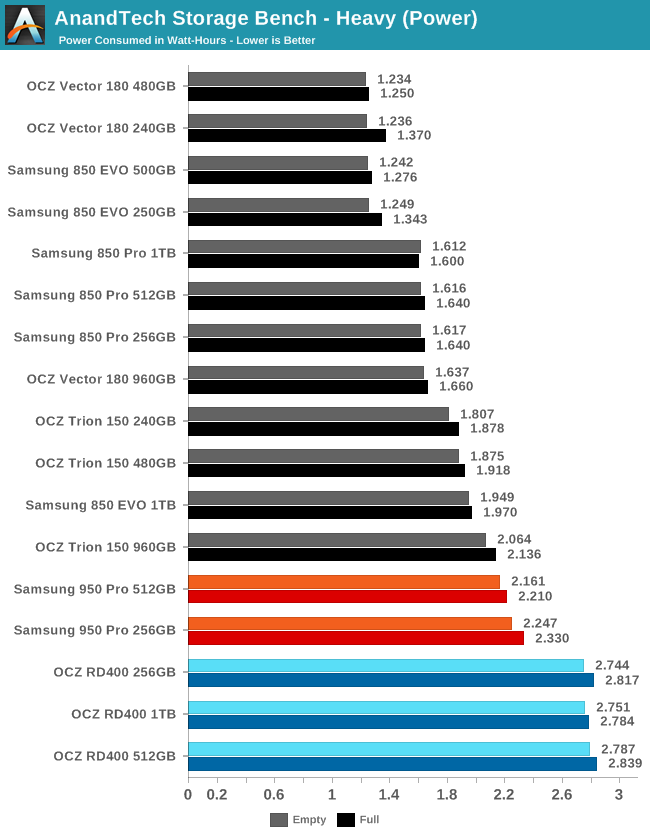The Toshiba OCZ RD400 (256GB, 512GB, 1TB) M.2 PCIe SSD Review
by Billy Tallis on May 25, 2016 8:02 AM ESTAnandTech Storage Bench - Heavy
Our Heavy storage benchmark is proportionally more write-heavy than The Destroyer, but much shorter overall. The total writes in the Heavy test aren't enough to fill the drive, so performance never drops down to steady state. This test is far more representative of a power user's day to day usage, and is heavily influenced by the drive's peak performance. The Heavy workload test details can be found here.

Samsung's PCIe 3 SSDs all clearly outclass the RD400 on the Heavy test, but the RD400 is slightly ahead of the Intel SSD 750 and much faster than everything else.

Average service time on the Heavy test shows clear separation between drive classes. The RD400 is relatively slow for a PCIe 3 SSD, but has less than half the latency of the good SATA drives and is five to ten times better than low-end TLC SATA drives.

The inclusion of a few TLC SATA drives shows how almost everything else handles the Heavy test without being overwhelmed, but the RD400 is also clearly lagging behind the other PCIe 3 drives and the 256GB model needs to perform better when full.

The three capacities of the RD400 all use very similar amounts of energy over the Heavy test, and significantly more than the other drives we've measured.










40 Comments
View All Comments
AnnonymousCoward - Wednesday, May 25, 2016 - link
What about boot time. Is it slow like the Intel card?mervincm - Wednesday, May 25, 2016 - link
Intel 750 SSD isn't slow at boot anymore. Later SSD firmware and NVME drivers have really helped my boot performance.Yregister - Thursday, November 3, 2016 - link
But that's on Windows, correct? I read that the 750 doesn't work on a Mac, not bootable...moheban79 - Saturday, November 12, 2016 - link
Thats not true. I got my Intel 750 booting up my hackintosh. Should be doable.adamto - Wednesday, May 25, 2016 - link
Why there is no 2T or even 4T M.2 SSD?Silma - Wednesday, May 25, 2016 - link
Because there isn't enough place on the stick. One would need to develop much denser NAND.Billy Tallis - Wednesday, May 25, 2016 - link
A double-sided M.2 2280 can usually fit four packages of flash, each containing a stack of up to 16 dies that are typically 128Gb (16GB). That multiplies out to a practical limit of 1024GB for now. Newer 3D NAND such as Micron's will be available in 256Gb MLC dies, enabling 2TB M.2 2280 drives (or 3TB with TLC).Dr.Neale - Wednesday, May 25, 2016 - link
Don't you mean 4 TB with TLC?Billy Tallis - Wednesday, May 25, 2016 - link
We're not quite there yet. Micron's 3D TLC is 384Gb and everybody else seems to be going for a 256Gb TLC that will be a smaller die than their 256Gb MLC. A 4TB M.2 would require either a 512Gb die or denser packaging.Chaser - Wednesday, May 25, 2016 - link
"Upgrading from a mechanical hard drive to a SSD alleviates a major performance bottleneck but the experience of moving from SATA SSDs to PCIe SSDs is not as revolutionary. I suspect most consumers would be better served with a larger SSD of moderate performance than a cramped but blazing fast PCIe drive," Thank you!